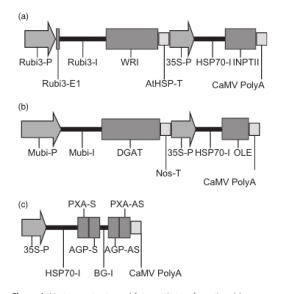Metabolic engineering of sugarcane to accumulate energy-dense triacylglycerols in vegetative biomass
Abstract
 Elevating the lipid content in vegetative tissues has emerged as a new strategy for increasing energy density and biofuel yield of crops. Storage lipids in contrast to structural and signaling lipids are mainly composed of glycerol esters of fatty acids, also known as triacylglycerol (TAG). TAGs are one of the most energy-rich and abundant forms of reduced carbon available in nature. Therefore, altering the carbon-partitioning balance in favour of TAG in vegetative tissues of sugarcane, one of the highest yielding biomass crops, is expected to drastically increase energy yields. Here we report metabolic engineering to elevate TAG accumulation in vegetative tissues of sugarcane. Constitutive co-expression of WRINKLED1 (WRI1), diacylglycerol acyltransferase1-2 (DGAT1-2) and oleosin1 (OLE1) and simultaneous cosuppression of ADP-glucose pyrophosphorylase (AGPase) and a subunit of the peroxisomal ABC transporter1 (PXA1) in transgenic sugarcane elevated TAG accumulation in leaves or stems by 95- or 43-fold to 1.9% or 0.9% of dry weight (DW), respectively, while expression or suppression of one to three of the target genes increased TAG levels by 1.5- to 9.5-fold. Accumulation of TAG in vegetative progeny plants was consistent with the results from primary transgenics and contributed to a total fatty acid content of up to 4.7% or 1.7% of DW in mature leaves or stems, respectively. Lipid droplets were visible within mesophyll cells of transgenic leaves by confocal fluorescence microscopy. These results provide the basis for optimizations of TAG accumulation in sugarcane and other high yielding biomass grasses and will open new prospects for biofuel applications.
Elevating the lipid content in vegetative tissues has emerged as a new strategy for increasing energy density and biofuel yield of crops. Storage lipids in contrast to structural and signaling lipids are mainly composed of glycerol esters of fatty acids, also known as triacylglycerol (TAG). TAGs are one of the most energy-rich and abundant forms of reduced carbon available in nature. Therefore, altering the carbon-partitioning balance in favour of TAG in vegetative tissues of sugarcane, one of the highest yielding biomass crops, is expected to drastically increase energy yields. Here we report metabolic engineering to elevate TAG accumulation in vegetative tissues of sugarcane. Constitutive co-expression of WRINKLED1 (WRI1), diacylglycerol acyltransferase1-2 (DGAT1-2) and oleosin1 (OLE1) and simultaneous cosuppression of ADP-glucose pyrophosphorylase (AGPase) and a subunit of the peroxisomal ABC transporter1 (PXA1) in transgenic sugarcane elevated TAG accumulation in leaves or stems by 95- or 43-fold to 1.9% or 0.9% of dry weight (DW), respectively, while expression or suppression of one to three of the target genes increased TAG levels by 1.5- to 9.5-fold. Accumulation of TAG in vegetative progeny plants was consistent with the results from primary transgenics and contributed to a total fatty acid content of up to 4.7% or 1.7% of DW in mature leaves or stems, respectively. Lipid droplets were visible within mesophyll cells of transgenic leaves by confocal fluorescence microscopy. These results provide the basis for optimizations of TAG accumulation in sugarcane and other high yielding biomass grasses and will open new prospects for biofuel applications.
